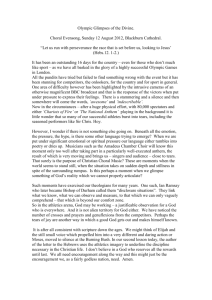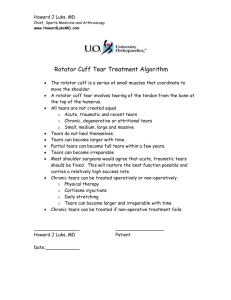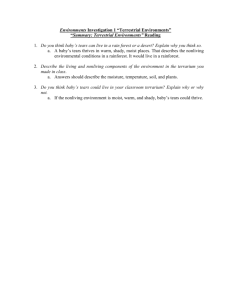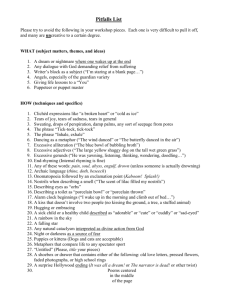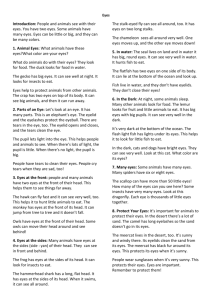Prevention and Management of Skin Tears
advertisement
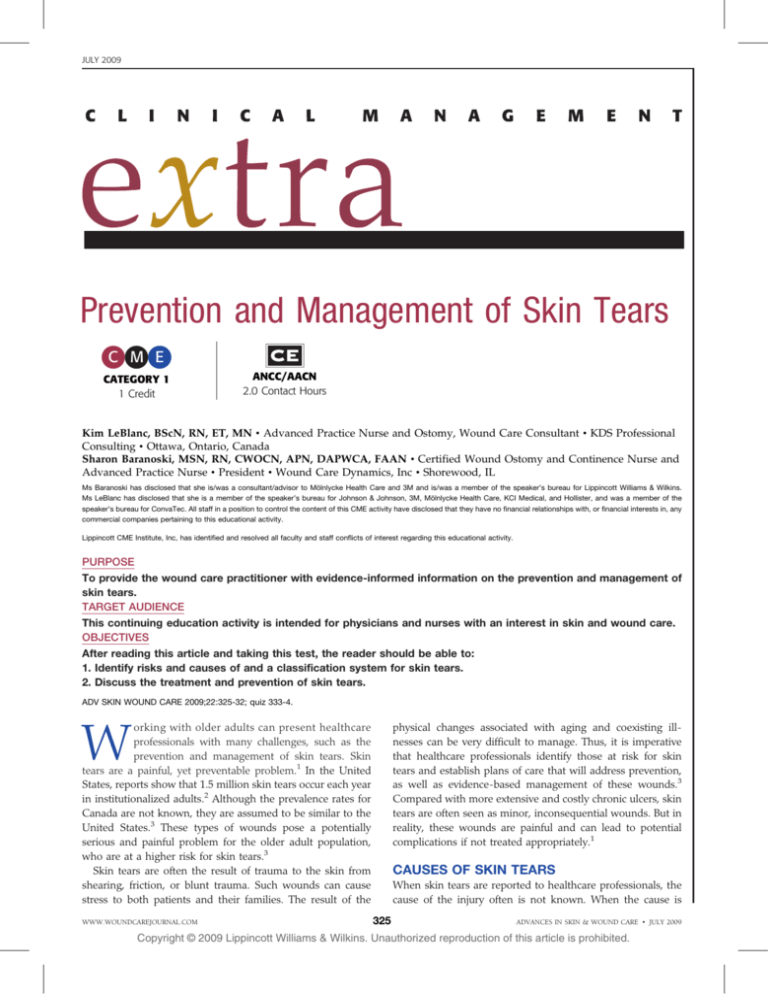
JULY 2009 Prevention and Management of Skin Tears C M E CATEGORY 1 1 Credit ANCC/AACN 2.0 Contact Hours Kim LeBlanc, BScN, RN, ET, MN & Advanced Practice Nurse and Ostomy, Wound Care Consultant & KDS Professional Consulting & Ottawa, Ontario, Canada Sharon Baranoski, MSN, RN, CWOCN, APN, DAPWCA, FAAN & Certified Wound Ostomy and Continence Nurse and Advanced Practice Nurse & President & Wound Care Dynamics, Inc & Shorewood, IL Ms Baranoski has disclosed that she is/was a consultant/advisor to Mölnlycke Health Care and 3M and is/was a member of the speaker’s bureau for Lippincott Williams & Wilkins. Ms LeBlanc has disclosed that she is a member of the speaker’s bureau for Johnson & Johnson, 3M, Mölnlycke Health Care, KCI Medical, and Hollister, and was a member of the speaker’s bureau for ConvaTec. All staff in a position to control the content of this CME activity have disclosed that they have no financial relationships with, or financial interests in, any commercial companies pertaining to this educational activity. Lippincott CME Institute, Inc, has identified and resolved all faculty and staff conflicts of interest regarding this educational activity. PURPOSE To provide the wound care practitioner with evidence-informed information on the prevention and management of skin tears. TARGET AUDIENCE This continuing education activity is intended for physicians and nurses with an interest in skin and wound care. OBJECTIVES After reading this article and taking this test, the reader should be able to: 1. Identify risks and causes of and a classification system for skin tears. 2. Discuss the treatment and prevention of skin tears. ADV SKIN WOUND CARE 2009;22:325-32; quiz 333-4. physical changes associated with aging and coexisting illnesses can be very difficult to manage. Thus, it is imperative that healthcare professionals identify those at risk for skin tears and establish plans of care that will address prevention, as well as evidence-based management of these wounds.3 Compared with more extensive and costly chronic ulcers, skin tears are often seen as minor, inconsequential wounds. But in reality, these wounds are painful and can lead to potential complications if not treated appropriately.1 orking with older adults can present healthcare professionals with many challenges, such as the prevention and management of skin tears. Skin tears are a painful, yet preventable problem.1 In the United States, reports show that 1.5 million skin tears occur each year in institutionalized adults.2 Although the prevalence rates for Canada are not known, they are assumed to be similar to the United States.3 These types of wounds pose a potentially serious and painful problem for the older adult population, who are at a higher risk for skin tears.3 Skin tears are often the result of trauma to the skin from shearing, friction, or blunt trauma. Such wounds can cause stress to both patients and their families. The result of the W WWW.WOUNDCAREJOURNAL.COM CAUSES OF SKIN TEARS When skin tears are reported to healthcare professionals, the cause of the injury often is not known. When the cause is 325 ADVANCES IN SKIN & WOUND CARE & JULY 2009 Copyright @ 2009 Lippincott Williams & Wilkins. Unauthorized reproduction of this article is prohibited. & unsteady gait & bruises Group 3: & physically abusive & resists ADL care & agitation & hearing impaired & decreased tactile stimulation & wheels self & manually/mechanically lifted & contracture of arm, legs, shoulders, hands & Hemiplegia/hemiparesis & trunkVpartial or total inability to balance or turn body & pitting edema of legs & open lesions on extremities & 3–4 senile purpuras on extremities & dry, scaly skin known, they are often linked to the following events: wheelchair injuries (25%), blunt trauma from accidentally bumping into objects (25%), transfers (18%), and falls (12.4%).4,5 White et al6 concluded that the key times when skin tears occur are during peak activity hours, from 6:00 to 11:00 AM and from 3:00 to 9:00 PM. White et al6 developed the Skin Integrity Risk Assessment Tool in 1994. The tool divided individuals into groups. Implementation of a skin tears prevention program should be performed if patients meet any of the criteria in group 1, 4 or more criteria in group 2, 5 or more criteria in group 3, or any combination of 3 criteria in group 2 with 3 or more criteria in group 3. Group 1: & history of skin tears within last 90 days & actual number of skin tears Group 2: & decision-making skills impaired & vision impairment & extensive assistance/total dependence for activities of daily living (ADLs) & wheelchair-assistance required & loss of balance & confined to bed or chair CATEGORIZING SKIN TEARS Payne and Martin7 established a classification system for skin tears in 1990 and revised it in 1993. Although generally accepted, the Payne-Martin classification system is not widely incorporated into practice. The classification centers around Figure 1. A, CATEGORY 1AVLINEAR TYPE (SKIN TEAR WITHOUT TISSUE LOSS). THE EPIDERMIS AND DERMIS ARE PULLED APART AS IF AN INCISION HAS BEEN MADE. B, CATEGORY 1BVFLAP TYPE. EPIDERMAL FLAP COMPLETELY COVERS THE DERMIS TO WITHIN 1 MM OF THE WOUND MARGIN. ADVANCES IN SKIN & WOUND CARE & VOL. 22 NO. 7 326 WWW.WOUNDCAREJOURNAL.COM Copyright @ 2009 Lippincott Williams & Wilkins. Unauthorized reproduction of this article is prohibited. dividing skin tears into 3 main categories with several subcategories. Figure 2. A, CATEGORY 2AVSKIN TEARS WITH PARTIAL TISSUE LOSS. SCANT TISSUE LOSS TYPE: 25% OR LESS OF THE EPIDERMAL FLAP LOST. B, CATEGORY 2B SKIN TEAR. MODERATE TO LARGE TISSUE TYPE: MORE THAN 25% OF THE EPIDERMAL FLAP LOST. Category 1 See Figures 1A and 1B for examples. A: Linear type, skin tear without tissue loss; the epidermis and dermis are separated as if an incision has been made B: Flap type, epidermal flap completely covers the dermis to within 1 mm of the wound margin Category 2 See Figures 2A and 2B for examples. A: Skin tears with partial tissue loss, scant tissue loss, 25% of the epidermal flap is lost B: Skin tears with partial tissue loss, moderate to large tissue loss, >25% of the epidermal flap is lost Category 3 See Figure 3 for examples. & Skin tear with complete tissue loss, epidermal flap is absent. INTRINSIC FACTORS RELATED TO SKIN TEAR DEVELOPMENT Skin tears result from shearing, friction, or blunt trauma that causes separation of skin layers. The subsequent wounds are partial- or full-thickness, depending on the degree of tissue damage.1 These wounds can be painful and can lead to complications if not treated appropriately.8 Subtle skin changes associated with aging increase the risk of skin tear development and interfere with the healing of the skin tear.1,9 Aging skin undergoes a process in which it experiences dermal and subcutaneous tissue loss, epidermal thinning, and serum composition changes, which cause decreased skin surface moisture. The skin’s elasticity and tensile strength decrease as these other changes occur.1,10 Dehydration, poor nutrition, cognitive impairment, altered mobility, and decreased sensation can also increase skin tear risk.3 Skin tears are often confused with pressure ulcers during assessments. Unlike pressure ulcers, despite the work conducted by White et al6 and Payne and Martin,7 there is no universally accepted risk assessment tool or classification system that has been adopted by the healthcare community.3 LeBlanc et al3 published Best Practice Recommendations for the Prevention and Treatment of Skin Tears in 2008. These recommendations included the following: & Identify and treat the cause ) Obtain a complete patient history ) Identify persons at high risk for skin tears ) Support the prevention of skin tears WWW.WOUNDCAREJOURNAL.COM 327 ADVANCES IN SKIN & WOUND CARE & JULY 2009 Copyright @ 2009 Lippincott Williams & Wilkins. Unauthorized reproduction of this article is prohibited. IDENTIFY AND TREAT THE CAUSE Figure 3. The key to any treatment program is an established prevention plan. To develop such a plan, it is imperative that a complete patient history, including general health status and risk factors, is known.8,9 Aside from the intrinsic factors discussed in this article, extrinsic factors also contribute to the development of skin tears. There is an increased risk for mechanical trauma when assistance is required for bathing, dressing, toileting, and transferring.6 Soap reduces the skin’s natural lubrication, and as a result, frequent bathing, coupled with the natural decrease in lubrication associated with aging, can result in dry skin. Dry skin is more susceptible to friction and shearing, making those with dry skin more susceptible to skin tears.6,11 Table 1 lists risk factors associated with the development of skin tears. CATEGORY 3 SKIN TEAR. SKIN TEAR WITH COMPLETE TISSUE LOSS; EPIDERMAL FLAP IS ABSENT. PREVENTION OF SKIN TEARS Prevention of skin tears presents a clinical challenge for healthcare professionals working with older adults. Table 1. RISK FACTORS ASSOCIATED WITH THE DEVELOPMENT OF SKIN TEARS3,12 & & & & & & & & & & & & & & & & & & & & & & & & Address patient-centered concerns ) Assess and assist with the development of a patientcentered plan of care & Local wound care ) Classify and document skin tears according to the degree of trauma ) Provide and support an optimal wound-healing environment ) Determine effectiveness of interventions ) Consider adjunctive therapies for nonhealing but healable skin tears & Provide organizational support ) Work within an interprofessional team ) Educate patient, caregiver, and healthcare professionals on the prevention and treatment of skin tears. ADVANCES IN SKIN & WOUND CARE & VOL. 22 NO. 7 328 Advanced age (>85 years of age) Sex (female) Race (white) Immobility (chair or bed bound) Inadequate nutritional intake Long-term corticosteroid use History of previous skin tears Altered sensory status Cognitive impairment Stiffness and spasticity Polypharmacy Presence of ecchymoses Dependence for ADLs Using assistive devices Applying and removing stockings Removing tape Vascular problems Cardiac problems Pulmonary problems Visual impairment Neuropathy Having blood drawn Transfers and falls WWW.WOUNDCAREJOURNAL.COM Copyright @ 2009 Lippincott Williams & Wilkins. Unauthorized reproduction of this article is prohibited. Providing daily care can be a challenge when caring for fragile skin, as even a slight bump can result in a skin tear. Adhesive tapes and advanced wound care dressing removal can also result in skin tears.1 Individuals dependent on others for total care are at the greatest risk for skin tears. Frequently, these individuals acquire skin tears during routine activities, such as dressing, bathing, repositioning, and transferring. Older adults who ambulate independently are another group at high risk; the majority of their skin tears occur on their lower extremities.6 Skin tears can be relatively simple to prevent if clinicians identify those at high risk during assessments and implement a prevention protocol. A systematic prevention protocol is required to ensure that measures are taken with every individual to prevent the occurrence of skin tears.1 Ratliff and Fletcher13 found that once an individual was identified at risk for skin tears, the implementation of prevention measures would decrease the incidence of skin tears. In a retrospective preintervention, Bank and Nix4 determined that the incidence of skin tears decreased after the implementation of a prevention program. Table 2. PREVENTION OF SKIN TEARS 14 & Wear long sleeves, long pants, or knee-high socks & Provide shin guards for those who experience repeat skin tears to shins 1,15,13,16 & Determine and remove potential causes for trauma 4,9,14,17 & Ensure a safe environment with adequate lighting 6,14,17,18 & Minimize objects that can be a source of blunt trauma 4,9,14,17 & Pad edges of furniture and equipment 4,9,14,17 & Provide an uncluttered pathway 9,14,17,18 & Avoid scatter rugs 3 & Responsible bathing 17 & Promote adequate nutrition and hydration & Avoid adhesive products on frail skin. If dressings or tapes are required, use paper tapes or soft silicone dressings to avoid skin stripping or tearing the skin with the removal 1,9,10,14,17,18 of adhesives & Keep fingernails and toenails cut short and filed to remove 18 rough edges to prevent self-inflicted skin tears & Educate staff on the importance of ‘‘gentle care’’ hypoallergenic moisturizers after showering while skin is still damp but not wet. Table 2 illustrates several prevention strategies to help reduce the risk for skin tears. Prevention Strategies With the aging process, skin becomes more susceptible to dryness. Bathing removes the body’s natural oils from the skin surface, and in older adults, this contributes to dry skin as natural oil production is diminished. Because baths are dehydrating, older adults should bathe every other day rather than daily. Showers that are not too long, nor too hot, are preferable. Optimally, tepid water is recommended. Homes heated too warmly in the winter months potentiate drying of the skin.3 Decrease the room temperature and use a humidifier to increase moisture. It is best to apply hypoallergenic moisturizers containing urea or lactic acid after bathing, with the skin damp, not wet; this will counteract some of the drying effects. Hydration needs to be distinguished from lubrication. Lubrication is the result of coating the skin’s surface with an oily covering that prevents water loss. Hypoallergenic moisturizers have a continuous water phase of suspended oil. When the water evaporates, the oil remains, thus hydrating the skin.19 LeBlanc et al3 define responsible bathing as based on individual need and preference; done with either soapless products or pH-balanced soaps; limited baths, shower instead with tepid/warm not hot water; and application of WWW.WOUNDCAREJOURNAL.COM Patient and Caregiver Education Effective patient and caregiver education is an essential component of successful skin tear prevention and management.3,28 By involving those at risk, their family members, and their caregivers in the prevention process, the healthcare provider will empower everyone involved to play a proactive role in skin tear prevention.3,28 An initial assessment of patients and their caregivers should be performed and documented, including baseline information pertaining to knowledge, beliefs, health practices, and perceived learning needs of patients, families, and caregivers. Cultural and psychological variables are also factors to consider in developing prevention and management strategies.3,28 TREATING SKIN TEARS The primary focus for treating skin tears should include the implementation of prevention strategies. Healthcare professionals must be equipped to manage these challenging wounds. Skin tears represent a specific type of wound; however, the same principles used to manage other wounds should be used when treating skin tears.3 329 ADVANCES IN SKIN & WOUND CARE & JULY 2009 Copyright @ 2009 Lippincott Williams & Wilkins. Unauthorized reproduction of this article is prohibited. Figure 4. A, TREATMENT OF A CATEGORY 3 SKIN TEAR WITH A CLEAR ACRYLIC, ABSORBENT TRANSPARENT FILM DRESSING IN AN 87-YEAR-OLD WOMAN. B, TREATMENT OF A CATEGORY 2 SKIN TEAR WITH 2-OCTYLCYANOACRYLATE TOPICAL BANDAGE IN A 92-YEAR-OLD MAN. options. They reported that most pretibial lacerations responded best to conservative management and that adhesive strips were preferable over suturing. This research supporting the use of adhesive strips is dated, and although no current research is available to support a change in practice, expert opinion suggests that adhesive strips are not the current treatment option of choice for these wounds.3,24,25 Nazarko17 reviewed the outcomes of a protocol for the treatment of skin tears. The protocol included using calcium alginates for the control of bleeding after injury and treating the tears according to the category of the tear, based on the Payne-Martin classification system. Category 1 skin tears were treated with adhesive strips anchor; category 2 skin tears were treated with a combination of adhesive strips and soft silicone, or low tact foam dressings; and category 3 skin tears were treated with soft silicone or low tact foam dressings. The review indicated that when using this protocol, skin tears tended to achieve wound closure within 7 to 10 days. O’Regan12 reviewed the existing literature on the treatment of skin tears. She concluded that wounds should be systematically cleaned with normal saline, bleeding controlled, clots removed, skin flap approximated if possible, and a hydrogel, alginate, petroleum gauze, foam, When developing any wound care treatment plan, regardless of the wound type, several areas must be addressed, including coexisting factors, nutritional support, pain management, local wound conditions, and optimal dressing selection.20 The first step in developing a treatment plan for skin tears is to complete a wound assessment. This includes assessing local conditions and determining the skin tear category using the Payne-Martin classification for skin tears.7,12 Next, remove bacteria and necrotic tissue, and select the appropriate dressing to maintain moisture balance. Moist wound healing versus a dry dressing is the method of choice. Actual product selection will depend on the wound assessment.20 Finally, remove the cause when possible. Dressing Selection Specific to Skin Tears Unlike chronic wounds, skin tears are acute wounds that have the potential to close by primary intention.12 Traditionally, many acute wounds are closed by primary intention and are secured with suture or staples.12 Given the fragility of the older adult’s skin,1,2,21 sutures and staples are not a viable option, and other methods are required.1,3,20,22,23 Sutton and Pritty23 conducted a randomized controlled study comparing pretibial laceration management ADVANCES IN SKIN & WOUND CARE & VOL. 22 NO. 7 330 WWW.WOUNDCAREJOURNAL.COM Copyright @ 2009 Lippincott Williams & Wilkins. Unauthorized reproduction of this article is prohibited. REFERENCES wound closure strip, hydrocolloid, or transparent film dressing be applied, depending on the wound bed characteristics. In the more recent literature, absorbent clear acrylic dressings3,25 have been used successfully to treat categories 1 to 3 skin tears with low to moderate exudate (Figure 4A). These dressings are semipermeable and can be left in place for up to 21 days. Another feasible option for categories 1 and 2 skin tears with less than 25% of epidermal flap loss is approximation of the wound edges. LeBlanc et al3 reported that an alternative to adhesive strips is the use of 2-octylcyanoacrylate topical bandage (skin glue).3,24,25 See Figure 4B. Milne and Corbett26 studied a convenience sample of 20 patients with categories 2 or 3 skin tears who were treated with 2-octylcyanoacrylate topical bandage. Complete wound closure was seen with 1 application, with no reported wound infection. Cost average was less than US $1 per application at the time of the study. Other possible topical treatment choices may include silicone-based contact layers or mesh,3,17 absorbent clear acrylic dressings,3 calcium alginate dressings,3,17 or foam dressings.3,17 The use of hydrocolloids or traditional transparent film dressings is not recommended, as they may cause skin stripping if not removed properly.3 In addition, the skin flap may be lifted during removal of adhesive products, and healing slowed.22 If the skin tear is infected or extensive, the wound should be assessed by a physician, enterostomal therapist, or another wound care specialist to determine the best treatment options.27 1. Baranoski S. How to prevent and manage skin tears. Adv Skin Wound Care 2003;16: 268-70. 2. Thomas Hess C. Skin IQ. Adv Skin Wound Care 2004;17:277. 3. LeBlanc K, Christensen D, Orsted HL, Keast DH. Best practice recommendations for the prevention and treatment of skin tears. Wound Care Canada 2008;6(1):14-32. 4. Bank D, Nix D. Preventing skin tears in nursing and rehabilitation center: an interdisciplinary effort. Ostomy Wound Manage 2006;52(9):38-40, 44, 46. 5. Patient Safety Advisory. Skin tears: the clinical challenge. Pennsylvania Patient Advisory Authority 2006;3(3) 5-10. http://patientsafetyauthority.org/ADVISORIES/AdvisoryLibrary/ 2006/Sep3(3)/Pages/01b.aspx. Last accessed April 29, 2009. 6. White MW, Karam S, Cowell B. Skin tears in frail elders: a practical approach to prevention. Geriatr Nurs 1994;15:95-9. 7. Payne RL, Martin ML. Defining and classifying skin tears: need for a common language. Ostomy Wound Manage 1993;39(5):16-20, 22-4, 26. 8. Cuzzell J. Wound assessment and evaluation: skin tear protocol. Dermatol Nurs 2002; 14:405. 9. Baranoski S. Skin tears: the enemy of frail skin. Adv Skin Wound Care 2000;13(3 Pt 1): 123-6. 10. Birch S, Coggins T. No-Rinse, one-step bed bath: the effects on the occurrence of skin tears in a long-term care setting. Ostomy Wound Manage 2003;49(1):64-7. 11. Brillhart B. Pressure sore and skin tear prevention and treatment during a 10-month program. Rehabil Nurs 2005;30(3):85-91. 12. O’Regan A. Skin tears: a review of the literature. World Counc Enteros Ther J 2002; 22(2):26-31. 13. Ratliff CR, Fletcher KR. Skin tears: a review of the evidence to support prevention and treatment. Ostomy Wound Manage 2007;53(3):32-4, 36, 38-40. 14. Ayello EA, Braden B. Why is pressure ulcer risk so important? Nursing 2001;31(11):74-9. 15. McGough-Csarny J, Kopac CA. Skin tears in institutionalized elderly: an epidemiological study. Ostomy Wound Manage 1998;44(3A Suppl):14S-25S. 16. Registered Nurses’ Association of Ontario (RNAO). Nursing best practice guideline: risk assessment and prevention of pressure ulcers. Toronto, Ontario, Canada: RNAO; 2005. 17. Nazarko L. Preventing and treating skin tears. Nurs Resid Care 2005;7:549-50. 18. Baranoski S. Skin tears. Nurs Manage 2001;32:25-31. 19. Sibbald RG, Cameron J, Alavi A. Dermatological aspects of wound care. In: Krasner D, Rodeheaver G, Sibbald G, eds. Chronic Wound Care: A Clinical Source Book for Healthcare Professionals. 3rd ed. Wayne, PA: HMP Communications; 2007. 20. Sibbald RG, Orsted HL, Coutts P, Keast D. Best practice recommendations for preparing the wound bed: update 2006. Wound Care Canada 2006;4(1):15-29. 21. Bryant R, Rolstand B. Examining threats to skin integrity. Ostomy Wound Manage 2001; 47(6):18-27. 22. Edwards H, Gaskill D, Nash R. Treating skin tears in nursing home residents: a pilot study comparing four types of dressings. Int J Nurs Pract 1998;4(1):25-32. 23. Farion KJ, Osmond MH, Hartling L, et al. Tissue adhesives for traumatic lacerations: a systematic review of RCTs. Acad Emerg Med 2003;10:110-8. 24. Fleck C. Preventing and treating skin tears. Adv Skin Wound Care 2007;20:315-20. 25. Roberts MJ. Preventing and managing skin tears: a review. J Wound Ostomy Continence Nurs 2007;34:256-9. 26. Milne CT, Corbett LQ. A new option in the treatment of skin tears for the institutionalized resident: formulated 2-octycyanacrylate topical bandage. Geriatr Nurs 2005;26:321-5. 27. Keast D, Parslow N, Houghton PE, Norton L, Fraser C. Best practice recommendations for the prevention and treatment of pressure ulcers: Update 2006. Wound Care Canada 2006;4(1):31-43. 28. Erwin-Toth P, Stenger B. Teaching wound care to patients, families and healthcare providers. In: Krasner D, Rodeheaver G, Sibbald G, eds. Chronic Wound Care: A Clinical Source Book for Healthcare Professionals. 4th ed. Wayne, PA: HMP Communications; 2007:45-50. CONCLUSION Skin tears represent a specific and challenging type of laceration that primarily affects older adults. Recently, increased attention has been given to these wounds in the literature. However, no widely accepted risk assessment or classification system exists to assist healthcare professionals with the prevention and treatment of these wounds. Prevention is the primary focus for managing skin tears. Maintaining skin integrity in patients who have frail skin requires awareness of the severity of the problem. A validated skin tear prediction scale and prevention and treatment guidelines are needed to address this common challenge. & WWW.WOUNDCAREJOURNAL.COM 331 ADVANCES IN SKIN & WOUND CARE & JULY 2009 Copyright @ 2009 Lippincott Williams & Wilkins. Unauthorized reproduction of this article is prohibited. For more than 50 additional continuing education articles related to Skin and Wound Care topics, go to NursingCenter.com/CE. CONTINUING MEDICAL EDUCATION INFORMATION FOR PHYSICIANS Lippincott Continuing Medical Education Institute, Inc. is accredited by the Accreditation Council for Continuing Medical Education to provide continuing medical education for physicians. Lippincott Continuing Medical Education Institute, Inc. designates this educational activity for a maximum of 1 AMA PRA Category 1 CreditTM. Physicians should only claim credit commensurate with the extent of their participation in the activity. PROVIDER ACCREDITATION INFORMATION FOR NURSES Lippincott Williams & Wilkins, publisher of the Advances in Skin & Wound Care journal, will award 2.0 contact hours for this continuing nursing education activity. LWW is accredited as a provider of continuing nursing education by the American Nurses Credentialing Center’s Commission on Accreditation. This activity is also provider approved by the California Board of Registered Nursing, Provider Number CEP 11749 for 2.0 contact hours. Lippincott Williams & Wilkins is also an approved provider of continuing nursing education by the District of Columbia and Florida #FBN2454. LWW home study activities are classified for Texas nursing continuing education requirements as Type 1. Your certificate is valid in all states. Complete registration information (Section A) and course evaluation (Section C). & Mail completed test with registration fee to: Lippincott Williams & Wilkins, CE Group, 333 7th Avenue, 19th Floor, New York, NY 10001. & Within 3 to 4 weeks after your CE enrollment form is received, you will be notified of your test results. & If you pass, you will receive a certificate of earned contact hours and an answer key. Nurses who fail have the option of taking the test again at no additional cost. Only the first entry sent by physicians will be accepted for credit. & & A passing score for this test is 13 correct answers. & Questions? Contact Lippincott Williams & Wilkins: 1-800-787-8985. PAYMENT AND DISCOUNTS The registration fee for this test is $21.95 for nurses; $20 for physicians. & & Take the test, recording your answers in the test answers section (Section B) of the CE enrollment form. Each question has only one correct answer. ADVANCES IN SKIN & WOUND CARE & VOL. 22 NO. 7 Nurses: Need CE STAT? Visit http://www.nursingcenter.com for immediate results, other CE activities, and your personalized CE planner tool. No Internet access? Call 1-800-787-8985 for other rush service options. Registration Deadline: July 31, 2011 (nurses); July 31, 2010 (physicians) CONTINUING EDUCATION INSTRUCTIONS Read the article beginning on page 325. & & & 332 Nurses: If you take two or more tests in any nursing journal published by LWW and send in your CE enrollment forms together, you may deduct $0.95 from the price of each test. We offer special discounts for as few as six tests and institutional bulk discounts for multiple tests. Call 1-800787-8985 for more information. WWW.WOUNDCAREJOURNAL.COM Copyright @ 2009 Lippincott Williams & Wilkins. Unauthorized reproduction of this article is prohibited.
